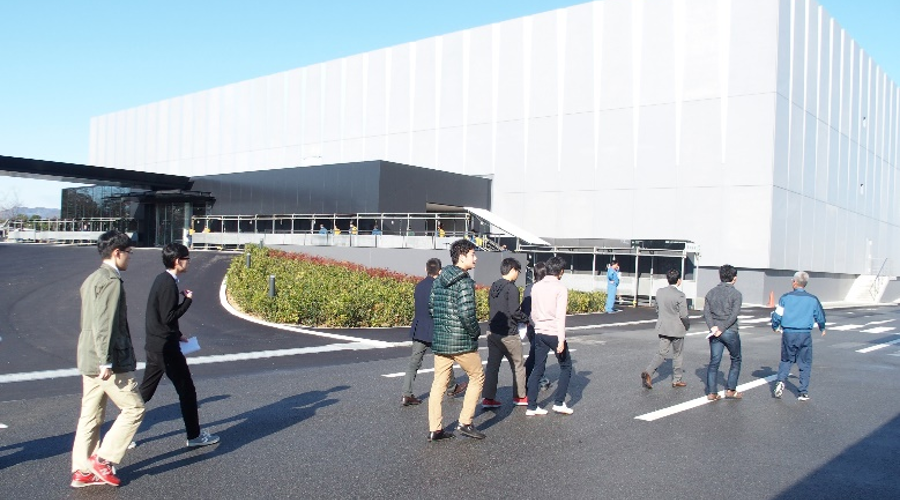On December 9, a delegation of the Young Generation Network of the Atomic Energy Society of Japan (JYGN), together with the Young Researcher’s Association of Japan Health Physics Society, visited Fukushima prefecture, including the site of TEPCO’s Fukushima Daiichi Nuclear Power Plant. JYGN has organized such Fukushima tours occasionally since 2011 to grasp up-to-date progress of decommissioning, remediation and reconstruction efforts after the accident. Their last visit was conducted in February 2016, when they were accompanied by a delegation of IYNC, ENS-YGN and YGNs in the Asia-Pacific region.
In the morning, we visited Fukushima Daiichi NPP. While decommissioning operation of damaged reactors will last for decades to come, we found some visible progress, such as, improvement of the management of contaminated water and radioactive waste, and improvement of the working environment.
Management of contaminated water deriving from the reactor and turbine buildings has been one of the major issues at the site for past few years. TEPCO already implemented several countermeasures including treatment and storage of such water, measures to control the ingress of groundwater to those buildings such as operation of pumping well, and installation of impermeable (freezing) wall at sea-side. Those measures seem effective, to some extent, until today. However, it will need more time to implement additional measures, such as operating another impermeable wall at land-side to prevent further ingress of ground water.
Management of radioactive waste, particularly solid waste, has also been improved. Majority of waste produced by decommissioning activities were stored safely and securely in the containers. Reduction of volume of waste and management of liquid waste, particularly discharge of treated water, would be important issues for next couple of years.
Improvement of working environment at the site is another important progress. Air dose rate at the site has been significantly decreased since the accident, achieved through several measures implemented by TEPCO. Now, workers need not to wear protective gears like full-face masks and Tyveks at the most of the areas, except inside of and close to the damaged reactors. Installation of new administration buildings and rest station, which hosts a cafeteria and a convenience store, provides more comfortable environment for the workers.
Other than the site itself, the visitor center was moved to former PR center from J-village, which has been utilized for the base of restoration and decommissioning operations after the accident and is originally a national training center for football. J-village is now under reconstruction and targeted to open again in 2018, prior to the Tokyo 2020 Summer Olympic Games.
In the afternoon, we visited the Fukushima Prefectural Center for Environmental Creation. This center is located 45km west of the Fukushima Daiichi NPP, and aims to monitor and analyze environment including its radioactivity, to conduct research toward environmental recovery, and to provide education on radiation, clean energy and environmental issues.
Its Communication Center is a unique and impressive facility. The complex includes a science museum and a history museum. You can learn basic science of radiation, clean energy and environment through quiz and experimental equipment, such as cloud chamber. You can also learn current and previous situations in Fukushima prefecture through graphical images with real numbers and data.
The history part is the most impressive one at the center. Starting from a short video introducing Fukushima prefecture, collection of symbolic front pages of local newspapers vividly shows you its course of recovery from the accident. Then you will be gripped by a precise and crafted miniature of damaged Fukushima Daiichi Nuclear Power Plant, positioned in front of a display of chronology after the accident. While the space is rather narrow than museums in the cities, you can definitely broaden your understanding on the consequences of the accident.
We are approaching the sixth anniversary of the accident next March. While we already learned a lot of lessons from the accident, mostly about safety measures and emergency responses, there would be still a number of lessons should be learned from our decommissioning and recovery efforts. JYGN is committed to continue sharing such lessons with international nuclear communities, including IYNC. We will welcome any young nuclear professionals interested in visiting Fukushima, since we believe visiting actual site is a good way to learn.
[Additional Resources] IYNC report on 2016 February Fukushima tour (IYNC Bulletin, July 2016 Edition)JYGN presentation at IYNC2016 on 2016 February Fukushima Tour
(Summary)
(Slides)
Information about Fukushima Daiichi NPP, including photos and videos, at TEPCO’s website
http://www.tepco.co.jp/en/decommision/index-e.html








